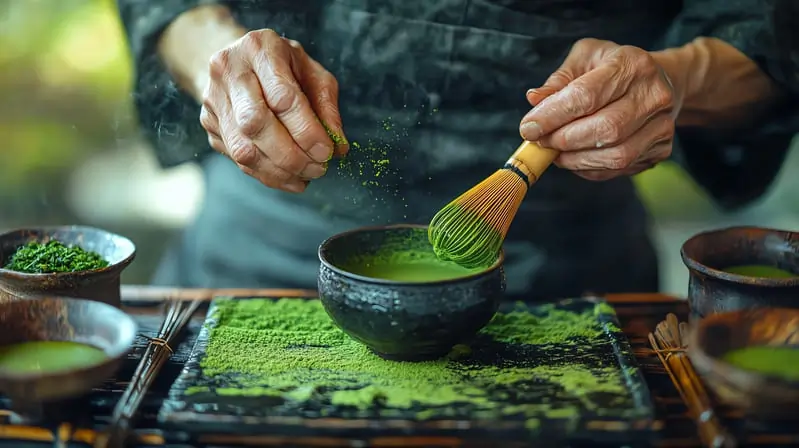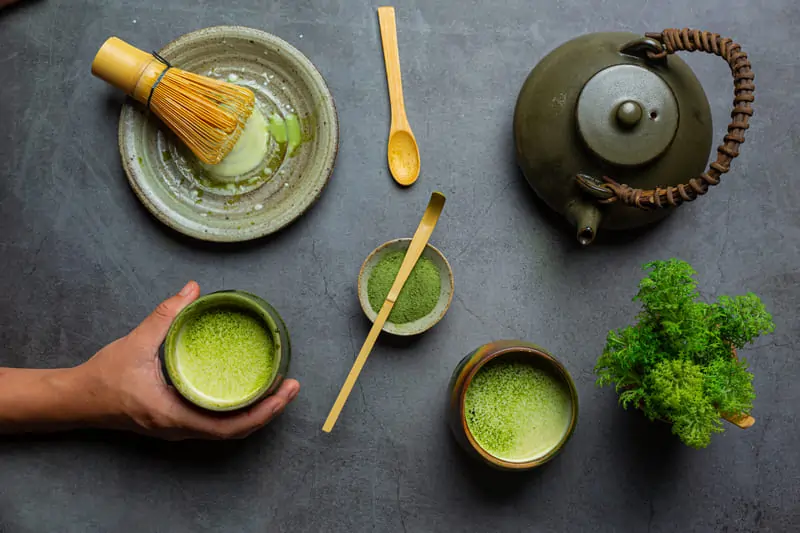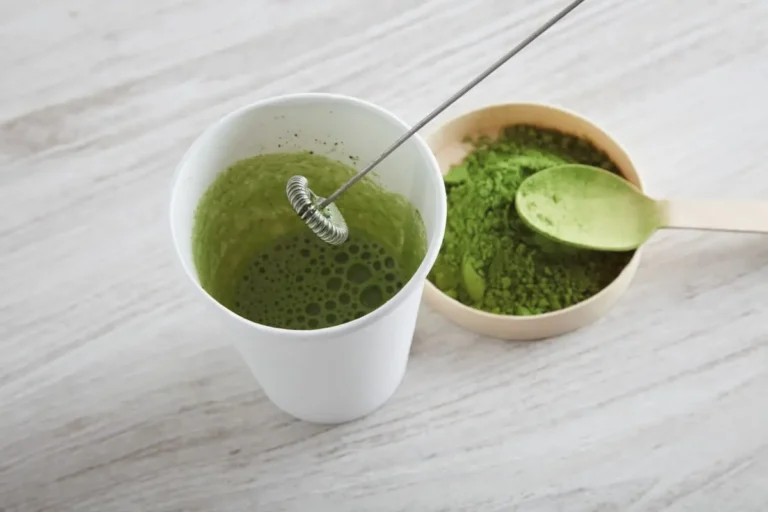What can you not mix with matcha, the vibrant green tea powder, is celebrated for its earthy flavor, vibrant hue, and numerous health benefits. However, knowing what to avoid mixing with matcha is crucial for preserving its delicate flavor and nutritional value. Below, we’ll explore the ingredients to avoid and provide tips for making the perfect cup of matcha.
If you enjoy exploring creative recipes, check out this guide on Matcha Tiramisu: A Perfect Fusion of Japanese and Italian Flavors for more inspiration.
Why Proper Matcha Pairing Matters
Matcha has a unique flavor profile—grassy, earthy, and slightly sweet—that can easily be overpowered by the wrong ingredients. Moreover, its antioxidants, specifically catechins, can be neutralized when combined with certain foods. Proper pairing not only enhances the flavor but also retains the health benefits.
If you’re looking for more creative ways to enjoy matcha with healthy snacks, you might love the Simple and Delicious 4-Ingredient Banana Bread.
Ingredients to Avoid Mixing with Matcha

While matcha is incredibly versatile, certain ingredients don’t pair well with its delicate, earthy flavor or nutritional profile. These missteps can either overwhelm matcha’s subtle notes or reduce its health benefits. To help you make the most of this vibrant green tea, here’s a detailed guide on ingredients to avoid and better alternatives to try instead.
1. Dairy Products (Cow’s Milk and Cream)
Cow’s milk and cream are common additions to lattes, but they can diminish the benefits and flavor of matcha:
- Suppresses Antioxidants: The casein proteins in dairy bind with matcha’s catechins (antioxidants), reducing their absorption and effectiveness. This interaction negates one of matcha’s key health benefits.
- Overpowers Flavor: Dairy’s strong, creamy taste can overshadow matcha’s delicate earthiness, making the drink feel heavy and less balanced.
Better Alternatives mix matcha
Plant-based milks are excellent substitutes that enhance rather than suppress matcha’s flavor:
- Almond Milk: Adds a mild, nutty note that pairs harmoniously with matcha’s natural bitterness.
- Oat Milk: Its creamy, neutral profile is ideal for creating rich lattes without overpowering matcha.
- Coconut Milk: Brings a touch of sweetness and tropical flair, making it a great choice for dessert-inspired drinks.
For dairy-free baking inspiration, explore this 4-Ingredient Banana Bread with Oil, which showcases how simple swaps can create healthier alternatives.
2. Sugary Additives and Artificial Sweeteners
While sweeteners can make matcha more approachable, sugary syrups and artificial options often detract from its flavor:
- Overpowers Delicate Notes: Sugary additives mask matcha’s subtle, grassy flavors, turning the drink overly sweet.
- Chemical Aftertaste: Artificial sweeteners can leave an unpleasant aftertaste that clashes with matcha’s smooth finish.
Healthier Alternatives of mix matcha

Natural sweeteners complement matcha’s flavor while adding depth:
- Honey: Enhances matcha’s natural sweetness with its mild floral notes.
- Maple Syrup: Provides an earthy sweetness that blends seamlessly into both hot and iced matcha drinks.
- Stevia: A calorie-free, plant-based option that sweetens without altering matcha’s essence.
For a creative pairing of natural flavors, try these Banana Bread Cookies, which fuse two classic desserts into a unique treat.
3. Boiling Water
Using boiling water to prepare matcha is one of the most common mistakes:
- Burns the Powder: Water above 85°C (185°F) can scorch matcha, resulting in a bitter, unpleasant taste.
- Ruins Texture: Overheating matcha can lead to clumping, creating a grainy consistency.
Tips for Proper Water Temperature
- Heat water to around 80°C (175°F) for the best results.
- If you don’t have a thermometer, let boiling water cool for 1–2 minutes before mixing with matcha.
This approach ensures matcha retains its smooth flavor and creamy texture. Learn more about perfecting preparation techniques in this Matcha Brewing Guide.
4. Overly Acidic Ingredients
Highly acidic ingredients like lemon, orange juice, or vinegar can disrupt matcha’s natural balance:
- Alters Texture: The acidity can destabilize matcha’s fine particles, leading to graininess.
- Creates Tanginess: The tangy flavor clashes with matcha’s subtle, earthy tones, making the combination unpleasant.
Exception
In small amounts, acidity can work in matcha desserts or cocktails when carefully balanced:
- Use a hint of lemon in matcha-flavored cakes or cookies for brightness without overpowering the tea.
For inspiration, explore this Matcha Tiramisu Recipe, where flavors are perfectly balanced to highlight matcha’s unique character.
5. Alcohol
While matcha may seem like an exciting cocktail ingredient, alcohol can pose challenges:
- Overwhelms Subtle Flavor: The bold taste of alcohol can dominate matcha’s delicate notes.
- Diminishes Nutritional Benefits: Alcohol can reduce matcha’s antioxidant properties, lessening its health appeal.
Best Uses of Alcohol with Matcha
- Matcha-Dusted Martinis: Use matcha as a garnish to add color and a hint of flavor without overwhelming the drink.
- Dessert Pairings: Incorporate small amounts of alcohol in desserts, like matcha tiramisu, where the flavors are carefully balanced to complement the tea.
For a perfectly blended matcha dessert, try this Matcha Tiramisu Recipe, which uses just the right amount of matcha to shine through every layer.
Final Thoughts
To fully appreciate matcha’s flavor and health benefits, it’s important to avoid pairing it with ingredients that not only overpower its delicate profile but also disrupt its natural balance. Instead, opt for plant-based milks, natural sweeteners, and proper preparation techniques to ensure matcha’s unique qualities take center stage.
Moreover, for more ideas on creating harmonious pairings, explore recipes like Banana Bread Cookies, which highlight how simple yet thoughtful combinations can elevate a dish. By doing so, you’ll gain a deeper understanding of what works and what doesn’t. As a result, every matcha creation you make will be as delicious as well as vibrant.
Best Practices for Preparing Matcha
To enjoy the full flavor and health benefits of matcha, careful preparation is key. By using the right tools, ingredients, and techniques, you can create a perfectly smooth and flavorful matcha experience every time. Here are the best practices for preparing matcha:
1. Use the Right Tools
Investing in traditional matcha tools ensures your preparation process is both authentic and effective:
- Bamboo Whisk (Chasen): A bamboo whisk is essential for achieving a smooth, frothy matcha. Its fine prongs are designed to blend matcha powder with water evenly, creating a creamy and lump-free consistency.
- Matcha Sifter: Sifting matcha powder before whisking eliminates clumps, ensuring a smoother texture.
- Ceramic Bowl (Chawan): A wide ceramic bowl allows for better whisking motion, making it easier to create frothy, velvety matcha.
For more insights into traditional matcha preparation, explore this Matcha Whisking Guide, which explains the benefits of using the right tools.
2. Opt for Plant-Based Milks
Plant-based milks are ideal for making matcha lattes, as they complement rather than overpower matcha’s natural flavors:
- Almond Milk: Its light and nutty flavor enhances matcha’s earthy notes, creating a balanced drink.
- Oat Milk: Creamy and neutral, oat milk pairs perfectly with matcha for a rich, satisfying texture.
- Coconut Milk: Adds a hint of natural sweetness and tropical flair, making it a great choice for dessert-inspired lattes.
Using these dairy-free options not only preserves matcha’s delicate flavor but also maintains its antioxidant benefits. For a dairy-free treat, consider pairing your latte with this 4-Ingredient Banana Bread with Oil.
3. Sweeten Naturally
When sweetening matcha, natural options are the best choice for maintaining balance:
- Honey: A mild floral sweetness that complements matcha’s grassy undertones.
- Maple Syrup: Adds a subtle, earthy sweetness that blends seamlessly into hot or iced matcha beverages.
- Stevia: A calorie-free alternative for those avoiding sugar, providing sweetness without overpowering matcha’s flavor.
Natural sweeteners enhance matcha’s taste without masking its distinct characteristics. For ideas on creative sweet pairings, explore this recipe for Banana Bread Cookies, which demonstrates how natural flavors shine in desserts.
4. Control Water Temperature
Water temperature is one of the most crucial factors in preparing matcha:
- Ideal Temperature: Use water heated to 80°C (175°F) to preserve matcha’s natural flavor and avoid bitterness.
- Cooling Method: If you don’t have a thermometer, boil water and let it cool for 1–2 minutes before pouring it over the matcha powder.
- Why It Matters: Boiling water can burn the delicate matcha powder, creating an unpleasant taste and reducing its vibrant green hue.
For detailed instructions on brewing matcha, check out this Matcha Brewing Guide to perfect your technique.
Final Thoughts
By following these best practices, you can fully enjoy the rich, earthy flavor and health benefits of matcha. From using the proper tools to sweetening naturally and selecting the right milk, each step contributes to a smoother, more flavorful experience.
For more inspiration on preparing matcha and pairing it with complementary treats, try this Matcha Tiramisu Recipe. It showcases how mindful preparation can elevate matcha into an unforgettable dessert or beverage.
FAQs About Matcha Pairings
1. What happens if you mix matcha with boiling water?
Boiling water burns matcha powder, making it bitter. Use water at 80°C (175°F) for the best results.
2. Can you mix matcha with coffee?
Yes, but balance is key. Matcha pairs well with espresso in drinks like dirty matcha lattes. Check out What is Matcha Tiramisu Made Of? for creative ideas.
3. Why does dairy milk not pair well with matcha?
Dairy suppresses matcha’s antioxidants and alters its natural flavor due to casein proteins.
4. What are the best sweeteners for matcha?
Natural options like honey and maple syrup enhance matcha’s flavor without overpowering it.
5. Is it okay to mix matcha with acidic ingredients?
Acidic ingredients can ruin matcha’s texture but may work in small, controlled quantities.
Conclusion
Knowing what not to mix with matcha is key to fully appreciating its unique taste and benefits. Avoid dairy, boiling water, and sugary additives, and instead, use plant-based milks, natural sweeteners, and proper preparation techniques.
Explore the world of matcha with recipes like Simple and Delicious 4-Ingredient Banana Bread and Banana Bread Cookies. Experiment with pairings to discover what works best for you!

